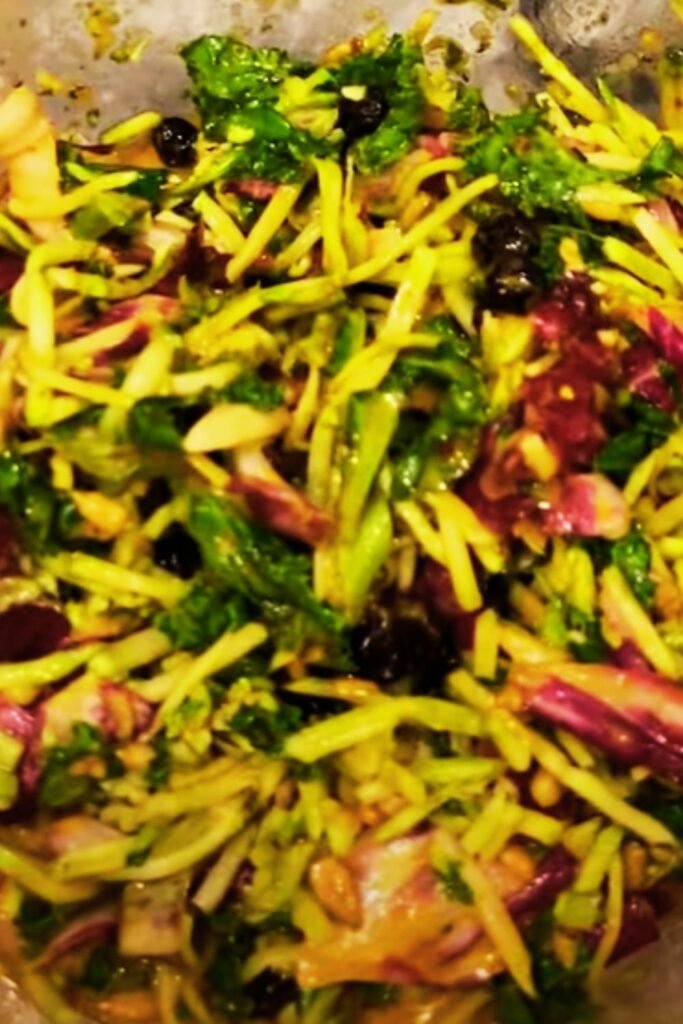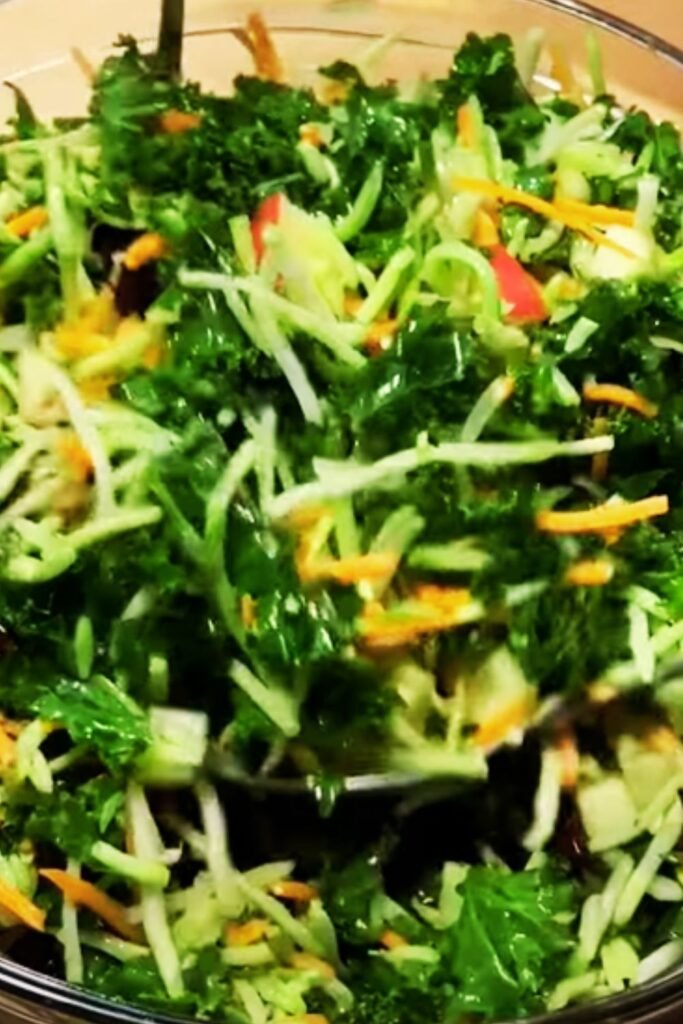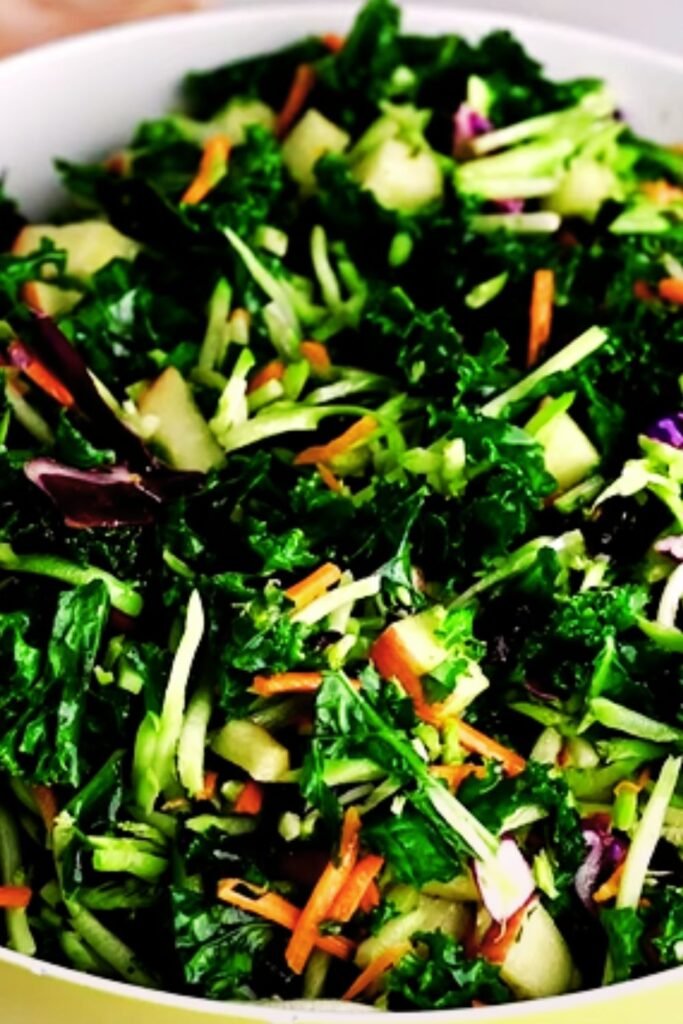I’ve been experimenting with healthy salads for over a decade, and I can confidently say that this Broccoli Kale Slaw Salad has become my absolute favorite go-to dish. There’s something magical about the combination of crispy broccoli florets, tender kale leaves, and a perfectly balanced dressing that makes this salad both nutritious and incredibly satisfying.
When I first discovered this recipe, I was looking for something that would give me the crunch I craved while packing a serious nutritional punch. What I found was so much more – a versatile, colorful salad that works as a side dish, light lunch, or even a crowd-pleasing potluck contribution. The best part? It actually gets better as it sits, making it perfect for meal prep enthusiasts like myself.
What Makes This Salad Special
Unlike traditional coleslaw that relies heavily on cabbage, my Broccoli Kale Slaw combines two nutritional powerhouses that complement each other beautifully. The broccoli provides that satisfying crunch we all love, while the kale adds a slightly bitter, earthy flavor that balances the sweetness of any added fruits or vegetables.
I’ve served this salad to skeptical family members who claimed they “don’t like kale,” only to watch them go back for seconds and thirds. The secret lies in how we prepare the kale – massaging it with a bit of salt and lemon juice breaks down its tough fibers, making it tender and more palatable.
Nutritional Benefits That’ll Blow Your Mind
Broccoli: The Green Superhero
Vitamin Content: One cup of raw broccoli provides over 100% of your daily vitamin C needs and nearly 25% of your vitamin K requirements.
Mineral Powerhouse: Rich in folate, potassium, and manganese, broccoli supports everything from heart health to bone strength.
Antioxidant Properties: Contains sulforaphane, a compound that has been studied for its potential anti-inflammatory and cancer-fighting properties.
Fiber Content: Provides both soluble and insoluble fiber, promoting digestive health and helping you feel full longer.
Kale: The Ultimate Leafy Green
Nutrient Density: Kale is one of the most nutrient-dense foods on the planet, containing vitamins A, C, and K in abundance.
Iron Content: Provides more iron per calorie than beef, making it an excellent choice for vegetarians and vegans.
Calcium Source: Contains more calcium per calorie than milk, supporting bone health naturally.
Detoxification Support: Rich in compounds that support the body’s natural detoxification processes.
Complete Nutritional Breakdown
| Nutrient | Per Serving (1 cup) | % Daily Value | Health Benefits |
|---|---|---|---|
| Calories | 45-60 | 2-3% | Low-calorie, weight-friendly |
| Protein | 3-4g | 6-8% | Muscle maintenance and repair |
| Fiber | 4-5g | 16-20% | Digestive health, satiety |
| Vitamin C | 120-150mg | 130-165% | Immune support, collagen production |
| Vitamin K | 180-220mcg | 200-245% | Bone health, blood clotting |
| Folate | 60-80mcg | 15-20% | Cell division, DNA synthesis |
| Iron | 1.5-2mg | 8-11% | Oxygen transport, energy production |
| Calcium | 90-110mg | 7-9% | Bone and teeth health |

The Perfect Broccoli Kale Slaw Recipe
Ingredients You’ll Need
For the Salad Base:
- 4 cups fresh broccoli florets, finely chopped
- 3 cups fresh kale leaves, stems removed and finely chopped
- 1 cup purple cabbage, thinly sliced
- 1/2 cup carrots, julienned or grated
- 1/3 cup red onion, thinly sliced
- 1/2 cup dried cranberries or raisins
- 1/3 cup toasted sunflower seeds or pumpkin seeds
- 1/4 cup fresh parsley, chopped
For the Creamy Dressing:
- 1/3 cup mayonnaise (or Greek yogurt for lighter version)
- 2 tablespoons apple cider vinegar
- 1 tablespoon honey or maple syrup
- 1 teaspoon Dijon mustard
- 1 clove garlic, minced
- 1/2 teaspoon salt
- 1/4 teaspoon black pepper
- 1 tablespoon lemon juice
Step-by-Step Preparation Method
Step 1: Prepare the Kale I always start with the kale because it needs a little extra attention. Remove the tough stems and chop the leaves into bite-sized pieces. Place them in a large bowl, sprinkle with a pinch of salt, and massage the leaves with your hands for about 2-3 minutes. This process breaks down the tough fibers and makes the kale much more enjoyable to eat.
Step 2: Prep the Broccoli Cut your broccoli into small, uniform florets. I prefer them to be about the size of a grape – small enough to eat easily but large enough to provide that satisfying crunch. If you’re using the stems (which I highly recommend because they’re nutritious and delicious), peel them and dice them finely.
Step 3: Prepare Supporting Vegetables Slice your purple cabbage as thinly as possible – a sharp knife or mandoline slicer works best. Grate or julienne the carrots, and slice the red onion into thin half-moons. The key here is uniformity in size so every bite has a perfect balance of flavors and textures.
Step 4: Make the Dressing In a separate bowl, whisk together all dressing ingredients until smooth and well combined. I like to make my dressing slightly more acidic than traditional coleslaw dressing because the robust flavors of broccoli and kale can handle it beautifully.
Step 5: Combine and Rest Add all the prepared vegetables to the bowl with the massaged kale. Pour the dressing over the mixture and toss thoroughly to ensure every piece is well coated. This is where the magic happens – let the salad rest in the refrigerator for at least 30 minutes before serving.

Preparation Time and Serving Information
| Aspect | Details |
|---|---|
| Prep Time | 20-25 minutes |
| Resting Time | 30 minutes minimum (recommended) |
| Total Time | 50-55 minutes |
| Servings | 6-8 as side dish, 4 as main |
| Storage | Up to 5 days refrigerated |
| Best Served | Chilled or at room temperature |
Customization Options That Work
Protein Additions for Main Course
- Grilled chicken breast, diced
- Hard-boiled eggs, chopped
- Chickpeas or white beans
- Tofu or tempeh, cubed
- Feta or goat cheese crumbles
Fruit Variations
- Fresh apple slices (toss with lemon juice)
- Dried cherries instead of cranberries
- Fresh grapes, halved
- Pomegranate seeds for extra crunch
Nut and Seed Options
- Toasted almonds, sliced
- Chopped walnuts
- Pine nuts
- Hemp seeds for extra protein
Dressing Alternatives
- Tahini-based: Replace mayo with tahini for a nutty flavor
- Avocado cream: Blend avocado with lemon juice and herbs
- Balsamic vinaigrette: For a lighter, more acidic option
Storage and Meal Prep Tips
One of the things I love most about this salad is how well it keeps. Unlike lettuce-based salads that wilt quickly, this sturdy combination actually improves with time. The vegetables soften slightly while maintaining their crunch, and the flavors meld together beautifully.
Storage Guidelines
| Storage Method | Duration | Quality Notes |
|---|---|---|
| Refrigerated (covered) | 3-5 days | Best quality first 3 days |
| Freezer | Not recommended | Texture deteriorates |
| Room temperature | 2-4 hours | Safe serving window |
Meal Prep Success Tips
Make Ahead Strategy: I often prepare this salad on Sunday for the week ahead. The key is to store it in an airtight container and give it a good stir before serving.
Dressing Separation: Store extra dressing separately and add as needed to prevent the salad from becoming soggy.
Fresh Element Addition: Add delicate ingredients like avocado or fresh herbs just before serving to maintain their quality.
Serving Suggestions and Pairings
This versatile salad works beautifully in numerous contexts. I’ve served it at summer barbecues, holiday dinners, and casual weeknight meals with equal success.
Perfect Pairings
- Grilled salmon or chicken
- Pulled pork or barbecue dishes
- Quinoa bowls or grain salads
- Soup and salad combinations
- Sandwich accompaniment
Presentation Tips
- Serve in a clear glass bowl to showcase the colorful ingredients
- Garnish with extra seeds or fresh herbs
- Add a lemon wedge for guests who want extra acidity
- Provide serving spoons rather than forks for easier handling

Troubleshooting Common Issues
Problem: Kale Too Tough
Solution: Massage longer with salt, or try blanching briefly in boiling water and shocking in ice water.
Problem: Salad Too Dry
Solution: Add more dressing gradually, or include a tablespoon of olive oil to the existing dressing.
Problem: Flavors Too Bland
Solution: Increase acid (lemon juice or vinegar) and salt. Sometimes a pinch of red pepper flakes adds the needed kick.
Problem: Salad Gets Soggy
Solution: Store components separately and combine just before serving, or drain excess liquid before serving.
Seasonal Variations Throughout the Year
Spring Version
Add fresh peas, radish slices, and fresh mint. Use a lighter vinaigrette instead of creamy dressing.
Summer Enhancement
Include fresh corn kernels, cherry tomatoes, and basil. Perfect for outdoor gatherings.
Fall Adaptation
Incorporate roasted butternut squash, dried cranberries, and toasted pecans. Add a maple-dijon dressing.
Winter Warmth
Include roasted brussels sprouts, dried fruits, and warming spices like ginger in the dressing.
Health Benefits Beyond Nutrition
Weight Management Support
The high fiber content and low calorie density make this salad excellent for weight management. The combination of protein from seeds and fiber from vegetables helps maintain satiety.
Digestive Health
Both broccoli and kale contain prebiotics that support beneficial gut bacteria. The fiber content promotes regular digestion and gut health.
Anti-Inflammatory Properties
The cruciferous vegetables in this salad contain compounds that may help reduce inflammation throughout the body.
Heart Health Support
The potassium from vegetables, healthy fats from seeds, and fiber content all contribute to cardiovascular health.
Frequently Asked Questions
Q: Can I make this salad without massaging the kale? A: While you can skip this step, I strongly recommend massaging the kale with salt and lemon juice. This process breaks down the tough fibers and makes the kale much more palatable and easier to digest. It only takes 2-3 minutes and makes a significant difference in the final texture.
Q: How long does this salad last in the refrigerator? A: This salad keeps beautifully for 3-5 days when stored properly in an airtight container. Unlike delicate lettuce salads, the sturdy vegetables in this recipe actually improve with time as the flavors meld together. Just give it a good stir before serving.
Q: Can I substitute the mayonnaise in the dressing? A: Absolutely! Greek yogurt works wonderfully as a lighter alternative, providing protein while maintaining creaminess. You can also use avocado-based dressings, tahini, or even a simple vinaigrette. Each option will give the salad a slightly different flavor profile.
Q: Is this salad suitable for people with dietary restrictions? A: This salad is naturally gluten-free and vegetarian. It can easily be made vegan by using a plant-based mayonnaise or yogurt alternative. For those avoiding nuts, simply omit the seeds or replace with roasted chickpeas for crunch.
Q: Can I add other vegetables to this recipe? A: Definitely! This recipe is very flexible. Bell peppers, snap peas, shredded brussels sprouts, or even roasted vegetables work well. Just maintain the balance between crunchy and tender elements, and adjust the dressing quantity accordingly.
Q: Why does my salad taste bitter? A: Bitterness usually comes from the kale, especially if it’s not massaged properly or if you’re using older leaves. Make sure to massage the kale thoroughly and consider adding a touch more honey or maple syrup to the dressing to balance the flavors.
Q: Can I prepare this salad for a large crowd? A: Yes! This recipe scales up beautifully. For large gatherings, I recommend preparing the vegetables and dressing separately, then combining them 1-2 hours before serving. This prevents the salad from becoming soggy and allows you to adjust seasoning as needed.
Q: What’s the best way to cut the broccoli for this salad? A: I cut the broccoli florets quite small – about grape-sized – so they’re easy to eat with a fork. Don’t waste the stems! Peel them and dice them finely; they add great crunch and nutrition. Using a sharp knife is essential for clean cuts that won’t bruise the vegetables.
This Broccoli Kale Slaw Salad has become a staple in my kitchen because it delivers on every front – nutrition, flavor, convenience, and versatility. Whether you’re looking for a healthy side dish, a satisfying lunch, or a make-ahead option for busy weeks, this recipe adapts to your needs while providing consistent, delicious results. The combination of textures and flavors creates a truly satisfying eating experience that proves healthy food doesn’t have to be boring.